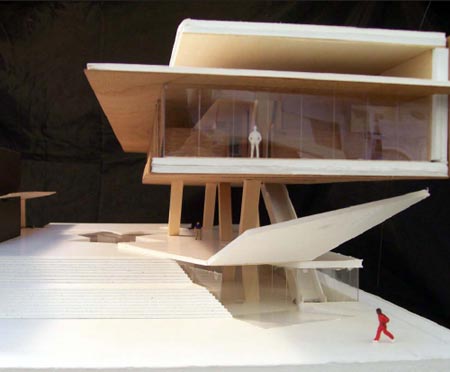
Image from archiPWNED portfolio entry (PDF)
Scott Nusinow, one of Cory Doctorow’s students in his University of Southern California class, ‘PWNED: Everyone on Campus is a Copyright Criminal‘, carried out an architectural concept project for the design of a Los Angeles library. He’s specifically addressed ‘architectures of control’ in the contexts of encouraging the public to use the library in an era where “the printed word… is marching towards obsolescence” and encouraging pedestrians to use the retail facilities on the same site (“by seeking to create a “positive feedback loop” of activity by funneling people towards the retail.”)
Scott’s full portfolio entry (PDF) has some interesting commentary, sketches, renderings and models. (As an aside, there’s something about architectural models that’s always fascinated me, and images such as the one above – even the surveillant pose of the figure in the window – evoke an odd mixture of Ballardian and Randian influences.)
I know there are some architecture graduates, students and enthusiasts who read this blog, but not knowing enough, myself, about the subject, I’d be very interested to know: To what extent are notions of control and behaviour-shaping taught as part of architectural training? This series of discussion board posts suggest that the issue is definitely there for architecture students, but is it framed as a conscious, positive process (e.g. “funnel the pedestrians past the shops”), a reactionary one (e.g. “use pebbled paving to make it painful for hippies to congregate“), or as something else entirely?
